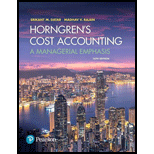
Horngren's Cost Accounting: A Managerial Emphasis (16th Edition)
16th Edition
ISBN: 9780134475585
Author: Srikant M. Datar, Madhav V. Rajan
Publisher: PEARSON
expand_more
expand_more
format_list_bulleted
Question
Chapter 21, Problem 21.17MCQ
To determine
It refers to the rate of return that is computed by the company to make a decision of selection of a project for investment. This rate provides the basis for selection of projects with lower cost of capital and rejection of project with higher cost of capital.
To identify: The correct option.
Expert Solution & Answer
Want to see the full answer?
Check out a sample textbook solution
Students have asked these similar questions
Camden Corp. sold 5,000 units of its product at a price of $82.00 per unit. The total variable cost per unit is $58, consisting of $35.50 in variable production cost and $22.50 in variable selling and administrative cost. Compute the manufacturing margin for the company under variable costing. a. $172,500 b. $192,500 c. $232,500 d. $410,000 e. ($140,000)
Can you solve this general accounting problem using accurate calculation methods?
Provide answer
Chapter 21 Solutions
Horngren's Cost Accounting: A Managerial Emphasis (16th Edition)
Ch. 21 - Capital budgeting has the same focus as accrual...Ch. 21 - List and briefly describe each of the five stages...Ch. 21 - Prob. 21.3QCh. 21 - Only quantitative outcomes are relevant in capital...Ch. 21 - How can sensitivity analysis be incorporated in...Ch. 21 - Prob. 21.6QCh. 21 - Describe the accrual accounting rate-of-return...Ch. 21 - Prob. 21.8QCh. 21 - Lets be more practical. DCF is not the gospel....Ch. 21 - All overhead costs are relevant in NPV analysis....
Ch. 21 - Prob. 21.11QCh. 21 - Distinguish different categories of cash flows to...Ch. 21 - Prob. 21.13QCh. 21 - How can capital budgeting tools assist in...Ch. 21 - Distinguish the nominal rate of return from the...Ch. 21 - A company should accept for investment all...Ch. 21 - Prob. 21.17MCQCh. 21 - Which of the following statements is true if the...Ch. 21 - Prob. 21.19MCQCh. 21 - Nicks Enterprises has purchased a new machine tool...Ch. 21 - Prob. 21.21ECh. 21 - Capital budgeting methods, no income taxes. Yummy...Ch. 21 - Capital budgeting methods, no income taxes. City...Ch. 21 - Prob. 21.24ECh. 21 - Capital budgeting with uneven cash flows, no...Ch. 21 - Comparison of projects, no income taxes. (CMA,...Ch. 21 - Payback and NPV methods, no income taxes. (CMA,...Ch. 21 - DCF, accrual accounting rate of return, working...Ch. 21 - Prob. 21.29ECh. 21 - Prob. 21.30ECh. 21 - Project choice, taxes. Klein Dermatology is...Ch. 21 - Prob. 21.32ECh. 21 - Selling a plant, income taxes. (CMA, adapted) The...Ch. 21 - Prob. 21.36PCh. 21 - NPV and AARR, goal-congruence issues. Liam...Ch. 21 - Payback methods, even and uneven cash flows. Sage...Ch. 21 - Replacement of a machine, income taxes,...Ch. 21 - Recognizing cash flows for capital investment...Ch. 21 - NPV, inflation and taxes. Fancy Foods is...Ch. 21 - NPV of information system, income taxes. Saina...
Knowledge Booster
Similar questions
- I am looking for the most effective method for solving this financial accounting problem.arrow_forwardI need help with this financial accounting question using the proper accounting approach.arrow_forwardPlease provide the accurate answer to this general accounting problem using valid techniques.arrow_forward
- Can you solve this general accounting question with accurate accounting calculations?arrow_forwardLauren Industries uses a predetermined overhead rate based on direct labor cost to apply manufacturing overhead to jobs. Last year, the company's estimated manufacturing overhead was $2,400,000, and its estimated level of activity was 80,000 direct labor-hours. The company's direct labor wage rate is $18 per hour. Actual manufacturing overhead amounted to $2,320,000, with actual direct labor cost of $1,485,000. For the year, manufacturing overhead was_.arrow_forwardI need help with this general accounting problem using proper accounting guidelines.arrow_forward
- The financial records for the Harrison Manufacturing Company have been destroyed in a fire. The following information has been obtained from a separate set of books maintained by the cost accountant. The cost accountant now asks for your assistance in computing the missing amounts. Direct Materials Inventory Debit Credit Beginning Balance 8,400 ? Transferred Out Purchases ? Ending Balance 6,800 Cost of Goods Sold Debit Credit 61,000 Work-in-Process Inventory Debit Credit Beginning Balance 7,900 ? Transferred Out Materials 18,800 Labor 13,900 Overhead 8,400 Ending Balance ? Finished Goods Inventory Debit Credit Beginning Balance ? ? Transferred Out Transferred In 39,900 Ending Balance 4,600 What is the value of the ending Work-in-Process inventory balance? Multiple Choice…arrow_forwardCan you explain the correct approach to solve this general accounting question?arrow_forwardNeed answerarrow_forward
arrow_back_ios
SEE MORE QUESTIONS
arrow_forward_ios
Recommended textbooks for you
 EBK CONTEMPORARY FINANCIAL MANAGEMENTFinanceISBN:9781337514835Author:MOYERPublisher:CENGAGE LEARNING - CONSIGNMENT
EBK CONTEMPORARY FINANCIAL MANAGEMENTFinanceISBN:9781337514835Author:MOYERPublisher:CENGAGE LEARNING - CONSIGNMENT Cornerstones of Cost Management (Cornerstones Ser...AccountingISBN:9781305970663Author:Don R. Hansen, Maryanne M. MowenPublisher:Cengage Learning
Cornerstones of Cost Management (Cornerstones Ser...AccountingISBN:9781305970663Author:Don R. Hansen, Maryanne M. MowenPublisher:Cengage Learning- Principles of Accounting Volume 2AccountingISBN:9781947172609Author:OpenStaxPublisher:OpenStax College
 Intermediate Financial Management (MindTap Course...FinanceISBN:9781337395083Author:Eugene F. Brigham, Phillip R. DavesPublisher:Cengage Learning
Intermediate Financial Management (MindTap Course...FinanceISBN:9781337395083Author:Eugene F. Brigham, Phillip R. DavesPublisher:Cengage Learning


EBK CONTEMPORARY FINANCIAL MANAGEMENT
Finance
ISBN:9781337514835
Author:MOYER
Publisher:CENGAGE LEARNING - CONSIGNMENT

Cornerstones of Cost Management (Cornerstones Ser...
Accounting
ISBN:9781305970663
Author:Don R. Hansen, Maryanne M. Mowen
Publisher:Cengage Learning

Principles of Accounting Volume 2
Accounting
ISBN:9781947172609
Author:OpenStax
Publisher:OpenStax College

Intermediate Financial Management (MindTap Course...
Finance
ISBN:9781337395083
Author:Eugene F. Brigham, Phillip R. Daves
Publisher:Cengage Learning